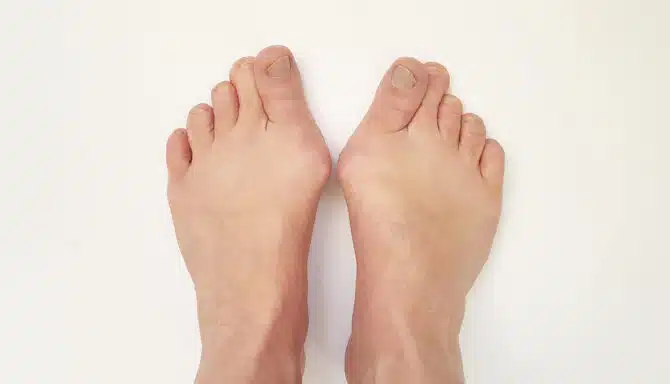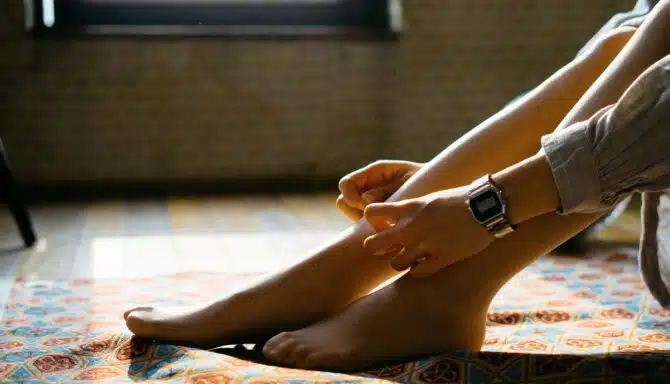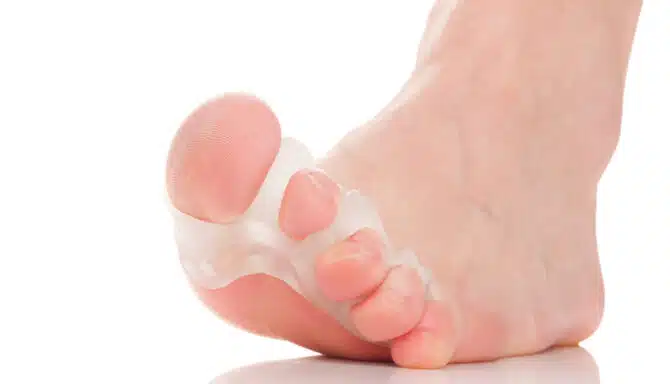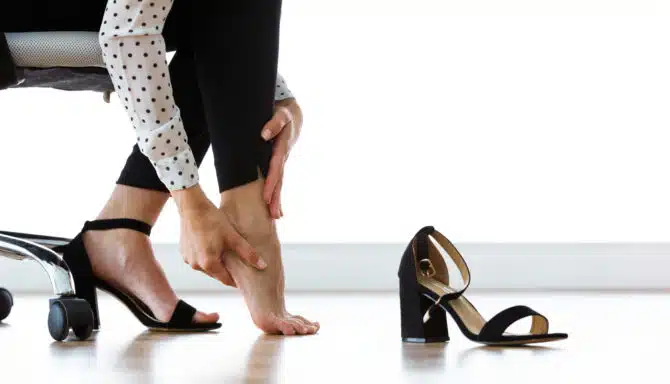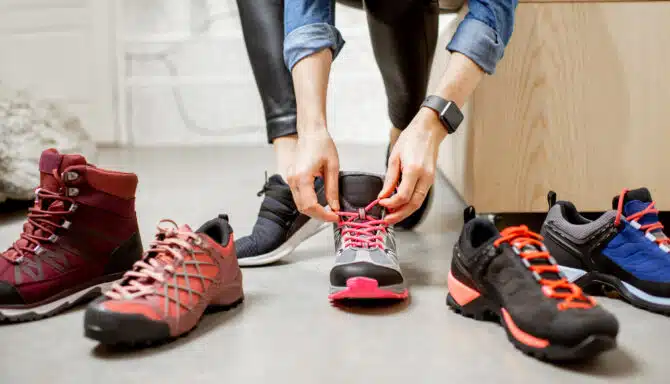August 12, 2024
Dealing with bunions can be a pain—literally. For those managing bunions, finding effective solutions can greatly improve quality of life. Let's dive into various bunion treatment options and explore lifestyle tips that can help alleviate discomfort and prevent further issues.
Bunion Treatment Options: Finding What Works for You
When it comes to managing bunions, there's no one-size-fits-all approach. Remember, they are bony protrusions and can vary in pain level and size. While they can occur in both men and women, they are most common in women. Non-surgical bunion treatment is often the first line of defense.
Non-Surgical Bunion Treatment
Ill-fitting and unsupportive footwear - particularly narrow shoes and high heels - is one of the most common causes of bunions. A chiropodist can suggest footwear for bunions that provide ample toe space and cushioning. They'll help you discover fashionable footwear for sensitive feet from your local Toronto foot clinic. Additionally, they can do a biomechanical assessment to determine if custom orthotics can help manage the bunion's progression and reduce your pain.
A chiropodist can also recommend bunion cushioning techniques and products, such as:
Silicone toe separators
Bunion aligners
Rigid, yet walkable, bunion splints
These non-invasive measures can help reduce pressure on the affected area and offer bunion pain relief.
Lifestyle Tips For Bunion Relief and Preventing Bunion Progression
As with any foot condition, lifestyle changes go a long way!
Implement simple bunion exercises into your routine to strengthen the muscles around the joint. To give it your best shot, refer to these 5 simple exercises for bunions!
It is also strongly recommended that you avoid high heels. If you have a special event, visit your local foot clinic to talk about comfortable heel and wedges you may be able to wear, for a limited amount of time.
In addition, avoid activities that put excessive pressure on your feet, such as long periods of standing on hard surfaces. You can try beginner-level, low-impact yoga to keep moving, but make sure it isn't too intense for your feet.
Surgical Solutions
In severe situations, bunion surgery from a podiatrist or orthopaedic surgeon can offer significant relief. Surgery realigns the toe joint, providing a long-term solution and eliminating the need to accommodate the bunion at all times.
However, it's crucial to consult with a healthcare professional to determine if surgery is the right step for you. Most of the time, surgery is only an option for severe bunions as it can be a lengthy and inconvenient process for you. In addition, there's no guarantee the bunion will not return: some studies indicate a reoccurence rate of up to 25% after bunion surgery.
It's important to note that bunion surgery alone isn't going to permanently get rid of your bunions: you still need to do non-surgical bunion treatment options after surgery to prevent reoccurence, namely:
Wear proper fitting footwear and avoid high heels
Strengthen and condition the muscles in your feet and ankles
Address any underlying biomechanical issues to reduce pressure and strain on the affected joint.
August 8, 2024
When we think about flexibility, our toes might not be the first body part that comes to mind. One may think that because they're so small, you can get away with neglecting them. However, our toes are actually part of our entire body's foundation. Flexible toes protect us from many short—and long-term foot conditions and can enhance our quality of life.
Let's explore the benefits of having flexible toes, including improved balance, fewer foot problems, and increased toe functionality.
Five benefits of flexible toes
1. Improved balance and stability
Flexible toes contribute to better balance and stability. When your toes can move and spread naturally, they can adjust to uneven surfaces and provide a broader support base, enhancing overall stability while walking, running, or standing.
2. Fewer foot problems
Maintaining flexibility in your toes can help prevent common foot problems associated with stiffness in your toes. For example, a limited range of motion in your feet can indicate bunions, hammertoes, osteoarthritis, hallux rigidus, and plantar fasciitis early. Hallux rigidus and hallux limitus translate to "rigid" and "limited," a direct sign of stiff toes.
In addition, flexible toes are less likely to become cramped or develop abnormal positions that can lead to discomfort and pain. Greater flexibility also means your muscle groups will work in balance, whereas stiff toes can overstress particular parts of your feet when they compensate for the stiffness.
You may also benefit from a reduced risk of one-time acute injuries like turf toe. With greater flexibility and range of motion, your toes can safely extend to positions they would not be able to if they weren't flexible.
3. Better proprioception
Proprioception is the body's ability to sense its position and movement in space. Flexible toes contribute to better proprioception in the feet, allowing for improved feedback to the brain about the terrain you're walking on, which aids in maintaining balance and preventing injuries.
4. Greater toe functionality
Flexible toes can better perform their natural functions, such as gripping the ground while walking or running. A greater range of motion helps propel you forward and reduces strain on other parts of the foot. Regular toe exercises can also increase blood flow to your toes, reducing swelling and inflammation.
5. Reduced risk of falls
Maintaining flexibility in your toes can reduce the risk of falls, especially among older adults. Flexible toes help adapt to sudden shifts in weight distribution and uneven surfaces, decreasing the likelihood of tripping or losing balance.
July 22, 2024
Sometimes with aging feet comes the development of toe deformities, particularly hammertoes. Studies show that approximately half of women over 70 have some version of a toe deformity (but they can happen to anyone). Many assume correcting hammertoes always leads to a daunting surgery, but guess what? Surgery is not usually the first option and is generally only considered when the toe becomes rigid, or other complications arise. Read today’s article to discover the best non-surgical solutions for hammertoes and toe alignment techniques that achieve amazing results.
Top Hammertoe Treatment Options
Innovation in foot care and toe straightening methods have lead to plenty of non-surgical solutions for hammertoes and the pain they cause, including:
Splinting, taping and bracing
Custom orthotics and new footwear
Shockwave therapy
At-home exercises
Other treatments
Splinting, Taping and Bracing
These non-invasive tools are great for dealing with toe curvature. All performed by a licensed Toronto chiropodist, splinting, taping and bracing helps straighten the toe, reduces friction and discomfort (corn development is common for people with hammertoes) and provides support and alignment.
Custom Orthotics And Footwear Changes
Custom orthotics are all about placing each part of your foot where it’s supposed to be, including toes. Wearing orthotics can properly align the joint in your toe and relax the burden on the affected tendons. Most importantly, they'll offset and redistribute pressure away from the toes. This will reduce strain on the hammertoes when you walk, which will help prevent them from getting worse.
As for footwear, avoid high heels if you have any toe deformity; they’re notorious for making hammertoes worse. Wear wide shoes, maybe even orthopedic shoes, that allow your toe abnormalities to exist comfortably and reduce pain as much as possible. Most importantly, make sure your shoes fit: If your shoes are too short, your toes will curl, which will make your hammertoes worse. (In fact, ill-fitting footwear is a major contributing factor to hammertoes.)
Shockwave Therapy
It’s clear that when you have hammertoes, your joints and tendons take a hit. They stiffen up, become quite painful, and may even weaken your muscles over time. Shockwave therapy is a non-invasive treatment that may help treat your tendons and ligaments.
At-Home Exercises
Check out exercises and stretches that help treat the top of the foot to soothe your hammertoes and strengthen your feet and muscles in general. Many of these target the toes and surrounding area. Strengthening the muscles in your feet ensures that the toes and joints don't get overworked or strained when you walk, which helps manage hammertoes and provides hammertoe pain relief.
Over-the-Counter Products
Gel separators, toe spacers, pads, cushions and more can help you take control of your hammertoes without resorting to surgery. Call your local Toronto foot clinic to see what they have in stock!
June 18, 2024
Foot-friendly shoes and comfortable heels as wedding guest footwear? Who knew there could be such a thing! Say goodbye to the days where you have to switch shoes halfway through the wedding reception and say hello to stylish comfort shoes, pain-free heels and podiatrist-approved footwear. Today’s article will guide you towards discovering brands that make comfortable wedges and heels for when you want to attend an exciting summer wedding, but don’t want to deal with dreaded foot pain!
Brands That Make Comfortable Wedding Season Footwear
Check out some foot clinic recommendations for wedding guests, bridal parties and bridal shoes! These brands are available at Feet First Clinic - your favourite local Toronto one-stop-shop for all things foot health!
Ara
Ara combines the perfect fit with sleek style, making the ideal shoe. They have plenty of pumps, sandals, and other shoes with a short-to-moderate heel height that will help you maintain your balance and stability at the wedding, in addition to preventing nagging foot pain. They use the same comforting shoe technologies and materials as their walking shoes.
NAOT
NAOT is another ideal choice for comfortable heels and wedges. Whether you're walking down the aisle or dancing the night away, you'll find a good combination of fashion and comfort with their sandals, booties and other shoes. If you're more into fun shoe designs and prefer a short heel with minimal elevation, they might be a good choice for you.
The NAOT Pixie might be a good choice for a wedding guest who wants a very short heel that still has some elevation.
Clarks
Clarks has always been innovative in shoemaking, introducing technologies that make you feel like you’re stepping on a cloud. This also applies to their chunky wedges, heeled sandals, boots, booties, and more — all perfect for summer weddings! Emphasizing proper fit and comfort with cushioned insoles and ergonomic designs and high-quality materials such as soft leathers, Clarks ensures that every pair minimizes foot pain as much as possible.
Give our Toronto foot clinic a call for the most up-to-date shoes from Ara, NAOT and Clarks in stock! You can also stop by our Bloor West location for a shoe fitting.
A Final Note on Heels and Wedding Season in 2024
It’s tough to find the right balance between high heels and foot health. We recommend avoiding them if you have certain foot conditions like severe bunions, hammertoes, joint pain caused by arthritis, amongst others. But then again, if you like heeled shoes, there should be a way to stay true to yourself, especially for a special occasion. Look for:
Wide-toed shoes: Opt for heeled shoes with a wide and deep toe box.
Low heels: Select heels that are no higher than 2 inches to reduce strain.
Soft materials: Look for shoes made from soft, flexible materials like leather or suede that can stretch and conform to the foot shape.
Cushioned and removable Insoles: Shoes with cushioned insoles can provide extra comfort. Removing them and inserting your own custom orthotics or insoles for your foot type is also a wise move.
Remember: if your shoes exacerbate your condition, don’t wear them, even if you’ve followed these guidelines. Walking shoes and orthopedic shoes can look lovely at a wedding too! Many brides wear them to add a fun, casual spin to their wedding look.
Check out this blog on balancing elegance with foot health for even more tips on selecting the right wedding shoes this summer.
February 15, 2024
High heels make a fashionable statement and give you a boost of confidence while taking your outfits to new heights. No one can deny, they look good! But are they good for your foot health? Should we really be wearing them? “Healthy high heels'' may seem like a misnomer, but the truth is, there are ways you can maintain your foot health, even as a high-heel lover. Let’s dive into the topic of healthy high heels and learn how you can simultaneously prioritize fashion trends and foot function.
Top 3 Ways to Protect Your Feet in Heels
While high heels may cause issues by altering the natural position of the foot-ankle complex, there are ways you can implement them into your daily life to minimize these effects:
Choose healthy high heels
Minimize high heel strain
Perform strengthening exercises
Choose Healthy High Heels
Fashionable foot health sometimes means avoiding risky shoe choices. If the main goal of wearing heels is to establish a stylish height that pairs well with clothing, there are options you can choose that aren’t the typical ultra-high, pointed-toe stiletto. Heeled shoes that focus on health can come as boots, wedges, and platforms - even pumps! All of which usually offer more stability, arch support and cushioning, without sacrificing style.
Minimize High Heel Strain
Minimizing high heel strain involves implementing some simple tips and remembering the importance of foot care in heels. Here are some to consider:
Take breaks
If you choose to wear a stiletto or another heel with a low level of support and stability, make sure you bring a back-up pair of shoes to change into when you need a break.
Opt for lower heels
Lower heels can prevent foot injuries by offering better stability and centre of gravity. Unsurprisingly, it is also easier to walk and maintain balance with a lower heel.
Opt for thicker heels
Thicker heels provide more support and stability than stilettos. They're also less likely to break than thin, hour-glass shaped heels. A broken heel poses a risk of tripping and falling.
Wear insoles with your heels
If your heels can accommodate them, wear Superfeet insoles for added comfort and support.
Ensure a proper fit
Unbeknownst to you, your feet can often change in size as the years pass. Make sure you try your heels on and walk around the store to assess how you move in them. Ensure there is ample room for your toes to reduce your risk of bunions, ingrown toenails, and more. Attending a proper shoe fitting at a foot clinic can also guarantee a perfect fit.
Perform Strengthening Exercises
There's no denying that wearing heels can be risky. You increase your chances of developing bunions, hammertoes, and other conditions, and sudden falls and foot injuries are more likely. That said, strengthening exercises for heel wearers can add an extra layer of protection against these issues! Try some toe-targeted exercises to keep those bunions at bay, and ankles movements to help with stability and balance.
Toe Splays
Sit or stand and spread your toes apart as far as you can.
Hold for a few seconds, then bring them back together.
Repeat for 10-15 repetitions.
Ankle Circles
Lift one foot off the ground and rotate your ankle clockwise for 15 seconds.
Reverse the direction and rotate counterclockwise for 15 seconds.
Switch to the other foot and repeat.
Towel Scrunches
Place a towel or piece of fabric on the floor and stand on it with your bare feet.
Scrunch the towel toward you using only your toes.
Repeat for 10-15 repetitions.
For a list of more extensive exercises that target the rest of the foot, check out these resources:
Top of the Foot Pain Exercises
Morning Foot Exercises to Start Your Day Pain Free
A Beginner’s Guide to Exercises for Relieving Arthritis
October 30, 2023
Sometimes your foot health depends on orthopedic shoes. For people with bunions, hammertoes, flat feet, arthritis, and other foot deformities, orthopedic footwear can make the difference between a painful day and a day where you can manage simple activities. Let’s take a look at the benefits of orthopedic shoes, the best practice for selecting orthopedic shoes, and how to use them.
Photo by iStock
Benefits of Orthopedic Shoes
Orthopedic shoes come with a wide array of qualities that promote foot health and tackle foot conditions. Here are some of the most notable:
Studies show that orthopedic footwear can improve the ability to maintain continuous walking in people with chronic foot and ankle injuries.
Many patients report their foot pain diminished after using orthopedic shoes for 1-2 years.
Orthopedic shoes can help you manage bunions so they don’t get worse and require surgery later.
They can help with proper foot alignment for people with plantar fasciitis and flat feet.
They usually provide extra heel cushioning and arch support.
To accommodate wide feet, orthopedic shoes often come with features like adjustable straps, extra wide toe boxes, and flexible fabric.
Photo by iStock
Selecting Orthopedic Shoes
Since choosing orthopedic shoes can be difficult, you should schedule a foot assessment with your chiropodist who will then prescribe orthopedic footwear. That said, here are three of the most important tips for finding the right orthopedic shoes for you:
Since your foot size can over time, especially with age, you should always triple check that your shoes fit snugly.
Make sure your new shoes are designed to best support your specific concern. For example, shoes with adjustable straps are good for wide bunions.
Consider your lifestyle and daily needs. Search for orthopedic sneakers if you’re trying to be more active, or orthopedic dress shoes if you need something for work.
Ensure any accessories like socks or custom orthotics fit properly with your shoes.
Usage of Orthopedic Shoes
You should use orthopedic shoes for activities they are designed for. For instance, if you have orthopedic dress shoes, use them for work and special occasions.
Furthermore, after wearing your shoes for some time, schedule a check up with your chiropodist so they can assess your progress and make any necessary adjustments or recommendations.
Photo by iStock
